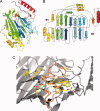Crystal structure of the variable domain of the Streptococcus gordonii surface protein SspB
- PMID: 19609934
- PMCID: PMC2777364
- DOI: 10.1002/pro.200
Crystal structure of the variable domain of the Streptococcus gordonii surface protein SspB
Abstract
The Antigen I/II (AgI/II) family of proteins are cell wall anchored adhesins expressed on the surface of oral streptococci. The AgI/II proteins interact with molecules on other bacteria, on the surface of host cells, and with salivary proteins. Streptococcus gordonii is a commensal bacterium, and one of the primary colonizers that initiate the formation of the oral biofilm. S. gordonii expresses two AgI/II proteins, SspA and SspB that are closely related. One of the domains of SspB, called the variable (V-) domain, is significantly different from corresponding domains in SspA and all other AgI/II proteins. As a first step to elucidate the differences among these proteins, we have determined the crystal structure of the V-domain from S. gordonii SspB at 2.3 A resolution. The domain comprises a beta-supersandwich with a putative binding cleft stabilized by a metal ion. The overall structure of the SspB V-domain is similar to the previously reported V-domain of the Streptococcus mutans protein SpaP, despite their low sequence similarity. In spite of the conserved architecture of the binding cleft, the cavity is significantly smaller in SspB, which may provide clues about the difference in ligand specificity. We also verified that the metal in the binding cleft is a calcium ion, in concurrence with previous biological data. It was previously suggested that AgI/II V-domains are carbohydrate binding. However, we tested that hypothesis by screening the SspB V-domain for binding to over 400 glycoconjucates and found that the domain does not interact with any of the carbohydrates.
Figures




References
-
- Jenkinson HF, Lamont RJ. Oral microbial communities in sickness and in health. Trends Microbiol. 2005;13:589–595. - PubMed
-
- Nyvad B, Kilian M. Comparison of the initial streptococcal microflora on dental enamel in caries-active and in caries-inactive individuals. Caries Res. 1990;24:267–272. - PubMed
-
- Jenkinson HF, Lamont RJ. Streptococcal adhesion and colonization. Crit Rev Oral Biol Med. 1997;8:175–200. - PubMed
-
- Rosan B, Lamont RJ. Dental plaque formation. Microbes Infect. 2000;2:1599–1607. - PubMed
-
- Douglas CW, Heath J, Hampton KK, Preston FE. Identity of viridans streptococci isolated from cases of infective endocarditis. J Med Microbiol. 1993;39:179–182. - PubMed
Publication types
MeSH terms
Substances
Grants and funding
LinkOut - more resources
Full Text Sources
Research Materials

